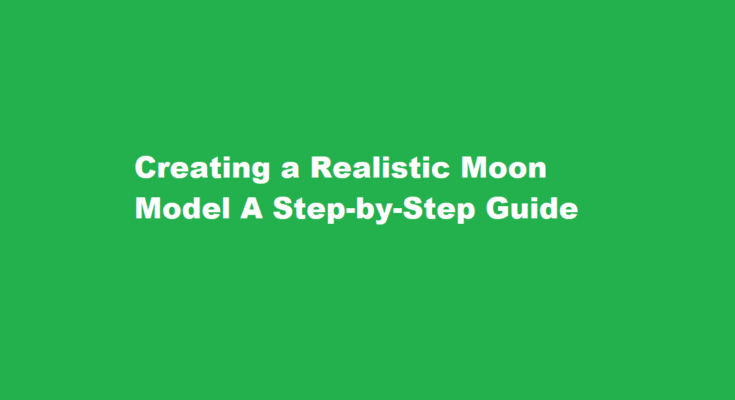The moon, Earth’s celestial companion, has fascinated humanity for centuries. Its serene beauty and enigmatic presence have inspired poets, scientists, and dreamers alike. Crafting a realistic moon model can offer a tangible connection to this celestial wonder and deepen our understanding of lunar features. In this guide, we will explore the steps to create a lifelike moon model that captures the essence of its surface and characteristics.
Materials Needed
1. Styrofoam Ball – To serve as the base for your moon model. Choose a size that suits your preference; a larger ball provides more surface area for intricate details.
2. Acrylic Paints – A range of grays, whites, and even subtle hints of pale blues or yellows for realistic coloring.
3. Paintbrushes – Various sizes, including fine brushes for detailed work.
4. Sponges and Cloths – For applying and blending paint.
5. Reference Images – High-resolution lunar photos to guide your model’s features.
6. Clear Sealant (optional) – To protect the finished model and enhance its appearance.
Step-by-Step Guide
1. Preparation
Gather all materials and set up your workspace. Lay down newspapers or a protective surface to catch any paint drips. Have reference images on hand to guide your painting process.
2. Base Coating
Begin by applying a base coat of light gray acrylic paint to the Styrofoam ball. This will serve as the foundation for your moon’s surface. Use a sponge or cloth to create a textured appearance, resembling the moon’s rough terrain.
3. Creating Lunar Features
Refer to your images to identify prominent lunar features such as craters, maria (dark areas), and highlands. Using a darker shade of gray, carefully paint these features onto your model. Remember that the moon’s surface isn’t uniform, so embrace variation and imperfections.
4. Adding Depth
To enhance realism, add subtle variations in color to your moon’s surface. Mix a bit of white or even pale blue into your gray paints to create different shades. Apply these shades sparingly, blending them gently with a cloth or sponge to achieve a natural, faded look.
5. Crater Detailing
Craters are a distinctive lunar feature. Using a fine brush, add shadows to the interior of craters by lightly brushing gray paint along their edges. This creates a sense of depth and realism. Additionally, consider adding tiny white dots along the crater rims to mimic the impact debris.
6. Mare Realism
For the maria or dark areas on the moon, use a slightly darker shade of gray. Apply this color to designated areas, ensuring a smooth transition between the highlands and maria. Again, blend the colors subtly to avoid harsh lines.
7. Highland Definition
The moon’s highlands are lighter, rugged areas. Add a touch of white to your base gray and gently highlight some raised areas on your model to simulate the highlands’ brightness.
8. Fine Details
Return to your reference images and identify smaller features such as rilles (channels), ejecta rays, and tiny craters. Use a fine brush to carefully paint these details, adding an extra layer of authenticity to your model.
9. Optional Sealant
Once you’re satisfied with the appearance of your moon model, you can apply a clear sealant to protect the paint and give the surface a subtle sheen. Make sure to follow the manufacturer’s instructions for application.
10. Display
Find a suitable stand or base to showcase your realistic moon model. Consider creating a lunar landscape setting to enhance its visual impact.
Frequently Asked Questions
What would the student need to do to model a Moon phase?
Students use Styrofoam balls to simulate the Moon, which will be lit by a single light source in the classroom. They observe how different portions of their ball are il- luminated as they hold it in various positions. They will create a complete series of phases matching the Moon’s appearance.
How do you make a perfect moon shape?
For a crescent moon, or any type of waxing or waning gibbous, the simplest way to get a perfect moon shape is to stack two circles on top of each other. “To make a crescent moon, I make two circles and move the top one around,” says illustrator Morgan Dees.
Conclusion
Crafting a lifelike moon model is a creative and rewarding endeavor. Through careful attention to detail, color blending, and the use of reference images, you can capture the moon’s captivating essence in a tangible form. Whether displayed as an educational tool or a work of art, your realistic moon model is sure to inspire wonder and curiosity about Earth’s closest celestial neighbor.
Read Also : Crafting Your Own Unique Glow-in-the-Dark Shoes A Step-by-Step Guide



